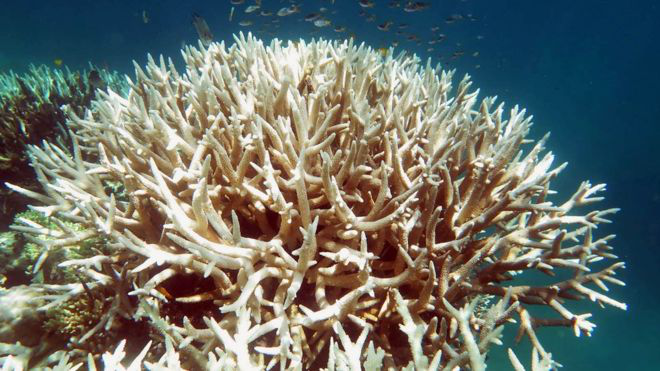
“Australia's Great Barrier Reef lost nearly a third of its corals in the past year, ”officials have said. This has led to widespread coral decline and habitat loss on the world's largest coral reef system. Surveys show that 29% of corals died in 2016, greater than the figure of 22% projected in mid-2016. The worst-hit area was near Port Douglas, where 70% of shallow water corals died, but there was a recovery of corals in the south of the reef.
The latest results come from surveys carried out by the Marine Park Authority, Queensland Parks and Wildlife Service, Australian Institute of Marine Science and the ARC Centre of Excellence for Coral Reef Studies. Great Barrier Reef Marine Park Authority chairman Russell Reichelt said, "As has been the case with reefs across the world, the Great Barrier Reef has experienced significant and widespread impacts over the last two years. We're very concerned about what this means for the Great Barrier Reef itself and what it means for the communities and industries that depend on it."
According to newspaper reports, a meeting over the reef's future recently told that the federal and Queensland government's long-term plan to protect the reef, announced in 2015, was no longer achievable. Bleaching occurs when the living on coral is expelled due to stress caused by extreme changes in temperature. This turns the coral white.
“In 2017, further coral die-offs are expected from the second year of bleaching in a row, and the impacts of tropical cyclone Debbie,” the officials said. Researchers say there is a significant driver behind the coral loss and experts have said the greenhouse gas emissions pushing up temperatures and harming the reef.
本时文内容由奇速英语国际教育研究院原创编写,未经书面授权,禁止复制和任何商业用途,版权所有,侵权必究!(投稿及合作联系:028-84400718 QQ:757722345)
1.Which part of Great Barrier Reef suffered most?
A Port Douglas.
B The south of the reef.
C Queensland Parks.
D The Marine Park.
解析:选A。细节理解题。根据第一段最后一句的The worst-hit area was near Port Douglas可以得知珊瑚受损最严重的区域是Port Douglas。故选A。
2.Why did the Great Barrier Reef Marine Park Authority carry the research?
A Because they wanted to know whether the Great Barrier Reef was hurt.
B Because they wondered what results the broken coral would bring in.
C Because they located the places where people can help the broken coral.
D Because they made sure that the reefs across the world was the same.
解析:选B。推理判断题。根据第二段最后一句的We're very concerned about what this means for the Great Barrier Reef itself and what it means for the communities可以推知,该研究机构做这项研究是因为他们非常关注大堡礁的珊瑚的死亡会带来什么结果。故选B。
3.What does the underlined word “bleaching” in the third paragraph mean?
A Changing in temperature.
B Meeting in the future.
C Protecting the reef.
D Turning white.
解析:选D。词义猜测题。根据第三段第三句的This turns the coral white可以得知bleaching指的是珊瑚“变白”。故选D。
4.What caused the loss of the corals?
A The climate change.
B The impacts of tropical wind.
C The habitat gains.
D The recovery of the reef.
解析:选A。细节理解题。根据最后一段最后一句的the greenhouse gas emissions pushing up temperatures and harming the reef可以得知温度变高导致了珊瑚的死亡,也就是说的天气变化的原因。故选A。